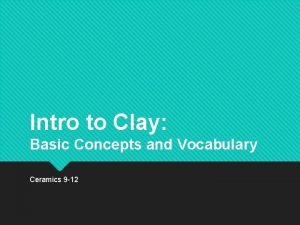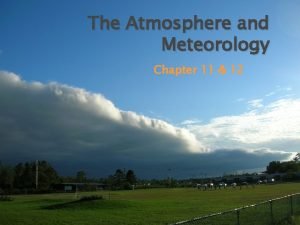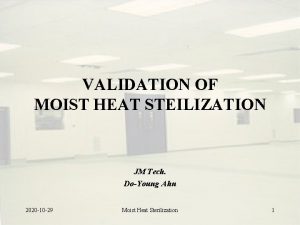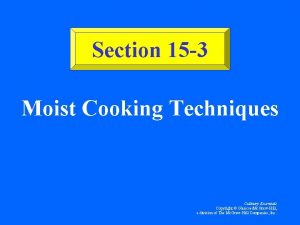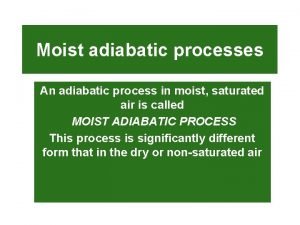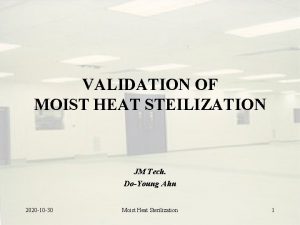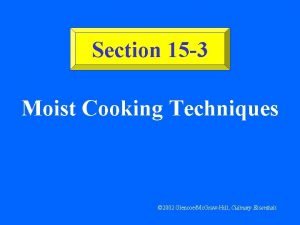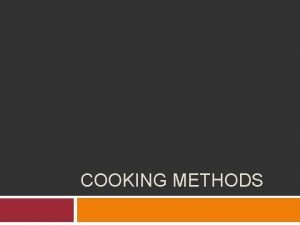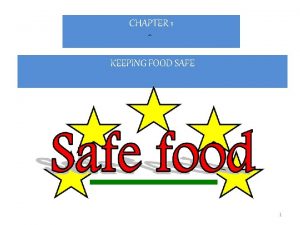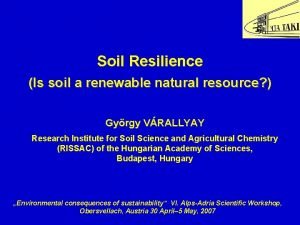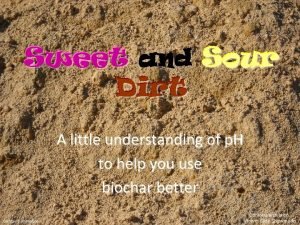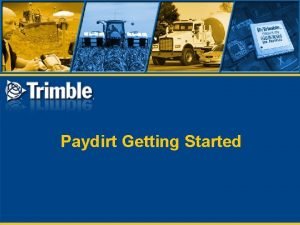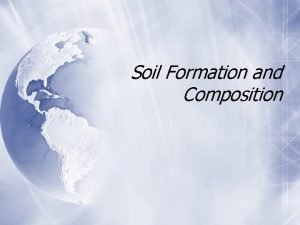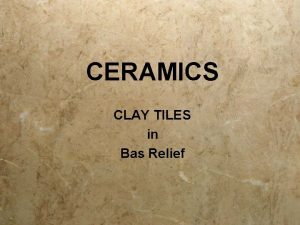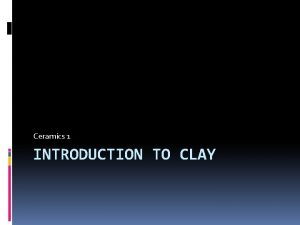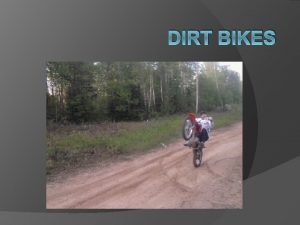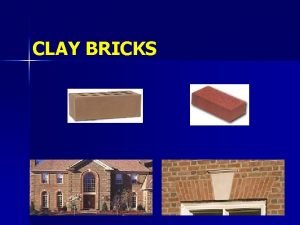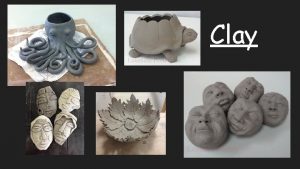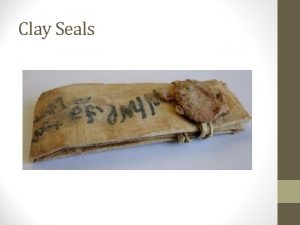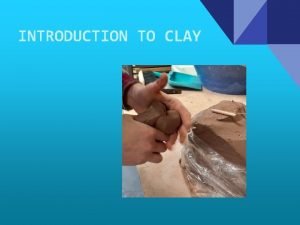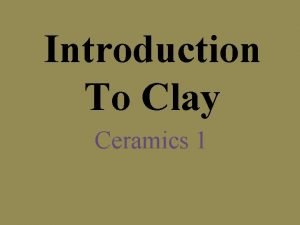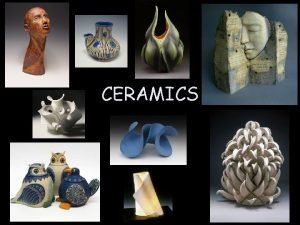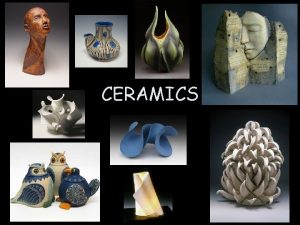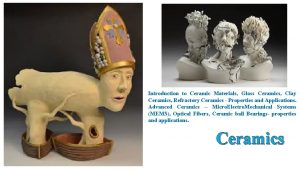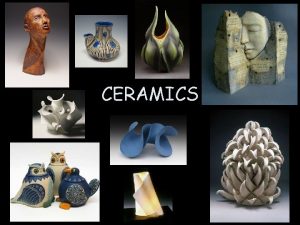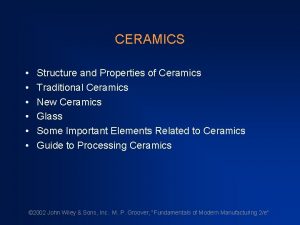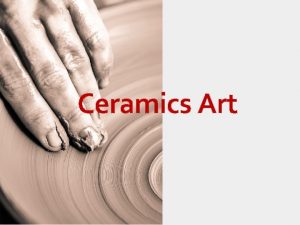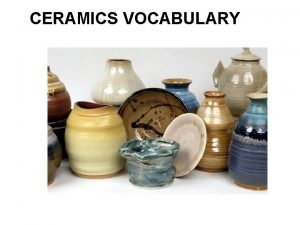CERAMICS CLAY Mud moist sticky dirt In ceramics




















- Slides: 20

CERAMICS

CLAY • • Mud; moist, sticky dirt. In ceramics, clay is finegrained, firm earthy material that is plastic when wet, brittle when dry, and very hard when heated.

The most common types of ceramic clays are: • • • earthenware, stoneware, and porcelain.

Earthenware • Earthenware is a lowfire clay that is porous and not waterproof.

Greenware • Greenware generally refers to unfired pottery.

Bone Dry • In ceramics, greenware which is thoroughly room dried is said to be bone dry.

• Leather-hard In ceramics, leather hard is a state in which clay has lost moisture to evaporation, but has not yet completely hardened. The clay is damp enough to be joined to other pieces with scoring and slip.

Bisque ware Clay that has been fired once but has not been glazed. Also called biscuit.

Firing • Firing is the process of baking and hardening pottery. Traditional Indian pottery is fired outdoors (rather than in a kiln) using various fuels including dried animal dung.

Firing Clay • Clay is hardened by heating it to a high temperature, thus fusing the clay particles. Temperature in kilns can reach 2500 degrees.

Kiln • A kiln is a furnace in which ceramics are fired. Kilns can be electric, natural gas, wood, coal, fuel oil or propane.

Slab Built • Clay slabs are cut to shape and joined together using scoring and wet clay called slip. Slabs can be draped over or into forms, rolled around cylinders or built-up into geometric forms.

• • Slip is a fine, liquid form of clay that is applied to the surface of a vessel prior to firing. slip is made by mixing finely ground clay with water.

• Slip is an inevitable byproduct of working on a potter's wheel, its name having resulted from potters' use of water to keep the spinning clay slippery as it's worked.

Slip • It is also used to cement together parts that have been formed separately.

Scoring • Making scratches or creases in pieces of clay to be joined together is called scoring.

Scoring • Scoring and applying slip to such roughened surfaces creates a bond that holds the pieces together.

• Scoring If slip acts as an adhesive, and scoring makes two pieces of clay like the opposite sides of a zipper, their combined action-a zipped zipper with hardened adhesive inside-- should be permanent.

Glaze • Glaze is a coating of material applied to ceramics before firing that forms a glass-like surface.

Glaze colored, • opaque, • translucent • or matte. •
 Pinch method ceramics definition
Pinch method ceramics definition Moist lining
Moist lining In orographic lifting clouds form when moist winds
In orographic lifting clouds form when moist winds Autoclave empty chamber temperature mapping
Autoclave empty chamber temperature mapping Cooking food in a liquid between 150-185 f
Cooking food in a liquid between 150-185 f Example of adiabatic process
Example of adiabatic process Jm tech
Jm tech Cooking food in a liquid between 150-185 f
Cooking food in a liquid between 150-185 f Chapter 5 kitchen essentials 2
Chapter 5 kitchen essentials 2 Veri moist
Veri moist Is microwaving a dry heat method
Is microwaving a dry heat method Keeping food safe chapter 1
Keeping food safe chapter 1 Example of dry heat
Example of dry heat Is dirt renewable
Is dirt renewable Alliteration songs lyrics
Alliteration songs lyrics Sour dirt
Sour dirt Paydirt software
Paydirt software Fitt acronym
Fitt acronym Vray curvature map
Vray curvature map The dirt
The dirt Is dirt abiotic or biotic
Is dirt abiotic or biotic
